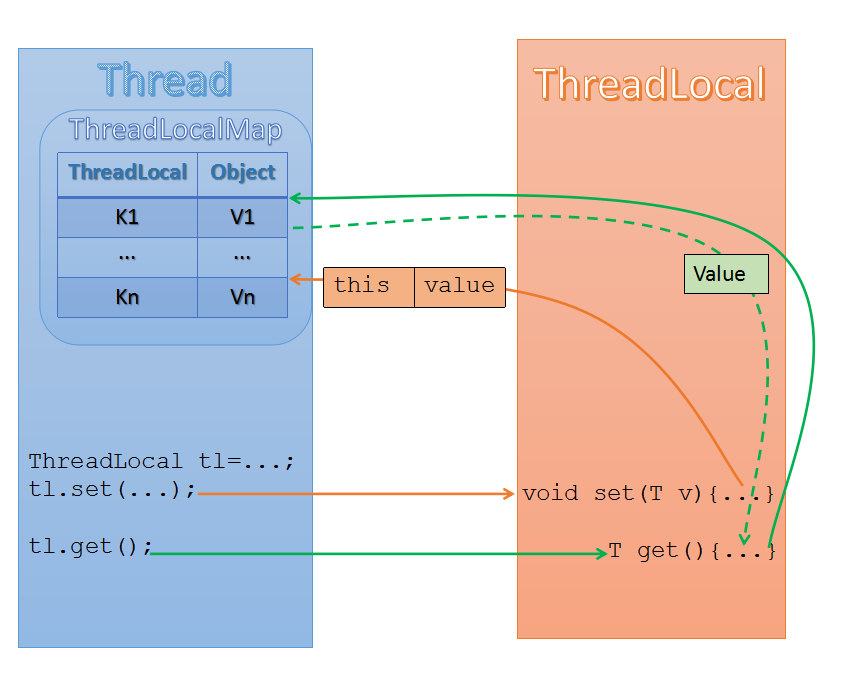本文是源码解析是基于JDK 1.7
注意:
Android内使用的ThreadLocal跟JDK内部的ThreadLocal具体实现有区别。但是他们所做的功能是一致的,只是Android针对ThreadLocal做了优化。但这不影响我们学习ThreadLocal的实现思想。
ThreadLocal的使用相信大家都比较熟悉,但是ThreadLocal内部是如何做到为不同线程保存不同的副本的呢?能看到这篇文章,说明你也跟我一样好奇。接下来我们一层一层解开ThreadLocal的面纱吧~
1. 涉及到的几个重要类
ThreadLocal里面的实现,主要涉及到以下几个重要类:
- Thread:大家很熟悉的线程类,一个
Thread类自然代表一个线程。- ThreadLocal:既然本文是要解析
ThreadLocal类,自然就离不开这个类啦~。- ThreadLocalMap:可以看成一个
HashMap,但是它本身具体的实现并没有实现继承HashMap甚至跟java.util.Map都沾不上一点关系。只是内部的实现跟HashMap类似(通过哈希表的方式存储)。- ThreadLocalMap.Entry:把它看成是保存键值对的对象,其本质上是一个
WeakReference<ThreadLocal>对象。
主要涉及到的类暂时只有这些,其中ThreadLocalMap和ThreadLocalMap.Entry的源码解析留到下一篇文章讲,在本文中,我们暂时不去牵扯它们的实现细节,我们只需在心中默默地为ThreadLocalMap打上HashMap的标签,把它暂时先当成HashMap来看待,ThreadLocalMap.Entry看成是保存<键,值>的对象。
2. ThreadLocal数据存取
2.1 set函数
我们知道,在使用ThreadLocal时,首先创建ThreadLocal对象,然后再调用其set(T)、T get()方法。我们从这些点切入,首先是构造函数如下:
public ThreadLocal() {
}- 1
- 2
可以看到,构造函数没有任何实现。接下来我们再从set函数切入:
/**
* Sets the current thread's copy of this thread-local variable
* to the specified value. Most subclasses will have no need to
* override this method, relying solely on the {@link #initialValue}
* method to set the values of thread-locals.
*
* @param value the value to be stored in the current thread's copy of
* this thread-local.
*/
public void set(T value) {
Thread t = Thread.currentThread();
ThreadLocalMap map = getMap(t);
if (map != null)
map.set(this, value);
else
createMap(t, value);
}- 1
- 2
- 3
- 4
- 5
- 6
- 7
- 8
- 9
- 10
- 11
- 12
- 13
- 14
- 15
- 16
- 17
代码整体流程很简单:
先拿到保存键值对的
ThreadLocalMap对象实例map,如果map为空(第一次调用的时候map值为null),则去创建一个ThreadLocalMap对象并赋值给map,并把键值对保存到map中。
当然了,虽然整体流程看起来简单,其内部实现需要我们理清!
我们看到,首先是拿到当前线程实例t,任何将t作为参数获取ThreadLocalMap对象。为什么需要通过Thread类来获取ThreadLocalMap对象呢?Thread类和ThreadLocalMap有什么联系?这些需要我们去看看getMap(Thread t)函数的实现:
ThreadLocalMap getMap(Thread t) {
return t.threadLocals;
}- 1
- 2
- 3
我们看到,getMap的实现非常简单!!!仅仅返回Thread实例的threadLocals属性。Thread中的ThreadLocalMap属性声明如下:
ThreadLocal.ThreadLocalMap threadLocals = null;- 1
我们先理一理,ThreadLocal的set(T)函数中,首先是拿到当前线程Thread对象中的ThreadLocalMap对象实例threadLocals ,然后再将需要保存的值保存到threadLocals里面。
换句话说,每个线程引用的ThreadLocal副本值都是保存在当前线程Thread对象里面的。存储结构为ThreadLocalMap类型,ThreadLocalMap保存的键类型为ThreadLocal,值为副本值。
2.2 get函数
有了set函数中的解析,我们对get函数就更容易理解了!先看看get函数源码:
/**
* Returns the value in the current thread's copy of this
* thread-local variable. If the variable has no value for the
* current thread, it is first initialized to the value returned
* by an invocation of the {@link #initialValue} method.
*
* @return the current thread's value of this thread-local
*/
public T get() {
Thread t = Thread.currentThread();
ThreadLocalMap map = getMap(t);
if (map != null) {
ThreadLocalMap.Entry e = map.getEntry(this);
if (e != null)
return (T)e.value;
}
return setInitialValue();
}- 1
- 2
- 3
- 4
- 5
- 6
- 7
- 8
- 9
- 10
- 11
- 12
- 13
- 14
- 15
- 16
- 17
- 18
同样的道理,拿到当前线程Thread对象实例中保存的ThreadLocalMap对象map,然后从map中读取键为this(即ThreadLocal类实例)对应的值。
如果map不是null,直接从map里面读取就好,如果map==null,那么我们需要对当前线程Thread对象实例中保存的ThreadLocalMap对象new一下。即通过setInitialValue函数来创建,setInitialValue函数具体实现如下:
private T setInitialValue() {
T value = initialValue();
Thread t = Thread.currentThread();
ThreadLocalMap map = getMap(t);
if (map != null)
map.set(this, value);
else
createMap(t, value);
return value;
}- 1
- 2
- 3
- 4
- 5
- 6
- 7
- 8
- 9
- 10
代码很简单,通过createMap来创建ThreadLocalMap对象,前面set函数里面创建ThreadLocalMap也是通过createMap来的,我们看看createMap具体实现:
void createMap(Thread t, T firstValue) {
t.threadLocals = new ThreadLocalMap(this, firstValue);
}- 1
- 2
- 3
这下对ThreadLocal的存取机制彻底清楚了吧!接下来一节我们以图形的形式做个总结。
3. 各个类之间关系
上图中绿色部分就是读取数据过程,橙色就是设置数据过程。
在下一篇文章中,我们将一起阅读ThreadLocalMap源码,看看ThreadLocalMap内部是如何实现类似Map的功能的。























 693
693

 被折叠的 条评论
为什么被折叠?
被折叠的 条评论
为什么被折叠?








